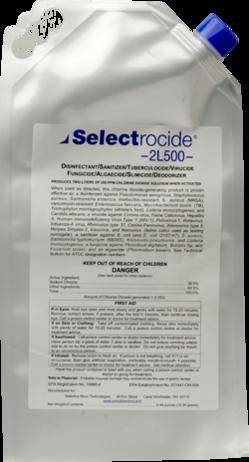Chlorine dioxide:
I plan to use chlorine dioxide at 0.25 ppm (residual) in nutrient solution, which has been found to not hinder root or plant growth, but offers sufficient efficacy to accomplish the above noted benefits.
Using choline dioxide should work much better than hydrogen peroxide, and it's easier to use and lasts a lot longer too. You buy a packet from SelectMicro, called "Selectrocide", and you mix it with distilled water to make a 500 ppm stock solution. Then you dilute it to whatever ppm you want. For constant use 0.25-0.5 ppm is recommend by Greenhouse Grower Magazine, in this good article "Chlorine Dioxide In Horticulture: A Technology Review" (P.Konjoian, 2011). P. Konjoian also covers use of higher ppm chlorine dioxide to kill root pathogens already going strong, like root rot.
It used to require a choline dioxide generator, on-site, to use chlorine dioxide for plants. Which is why I think it never caught on for cannabis growers. I have never read a single grower ever write about it, before myself (that's not to say no one has, I could be ignorant). Now, thanks to SelectMicro we can have ultra pure choline dioxide stock solution for low cost per packet. Sadly, the only retail sources at this time sell in bundles of a 5 or 10 or more packets, so it's at least ~$150 to get going with chlorine dioxide ... unless the owner of Custom Hydro Nutrients would carry it and sell them by single packs ... hint, hint to CHN
Here's what I'm testing this next grow at 0.25 ppm, I should have it in by next week some time:
http://www.selectivemicro.com/products_selectrocide2l500.php

- Stops algae growth in reservoir and on media
- Prevents drip emitter clogging from microbial biofilm
- Prevents root pathogens and reduces nitrification of NH4 into NO3
- Etc.
I plan to use chlorine dioxide at 0.25 ppm (residual) in nutrient solution, which has been found to not hinder root or plant growth, but offers sufficient efficacy to accomplish the above noted benefits.
Using choline dioxide should work much better than hydrogen peroxide, and it's easier to use and lasts a lot longer too. You buy a packet from SelectMicro, called "Selectrocide", and you mix it with distilled water to make a 500 ppm stock solution. Then you dilute it to whatever ppm you want. For constant use 0.25-0.5 ppm is recommend by Greenhouse Grower Magazine, in this good article "Chlorine Dioxide In Horticulture: A Technology Review" (P.Konjoian, 2011). P. Konjoian also covers use of higher ppm chlorine dioxide to kill root pathogens already going strong, like root rot.
It used to require a choline dioxide generator, on-site, to use chlorine dioxide for plants. Which is why I think it never caught on for cannabis growers. I have never read a single grower ever write about it, before myself (that's not to say no one has, I could be ignorant). Now, thanks to SelectMicro we can have ultra pure choline dioxide stock solution for low cost per packet. Sadly, the only retail sources at this time sell in bundles of a 5 or 10 or more packets, so it's at least ~$150 to get going with chlorine dioxide ... unless the owner of Custom Hydro Nutrients would carry it and sell them by single packs ... hint, hint to CHN
Here's what I'm testing this next grow at 0.25 ppm, I should have it in by next week some time:
http://www.selectivemicro.com/products_selectrocide2l500.php
The Selectrocide® 2L500 generates 2 liters of 500 ppm ultra pure Chlorine Dioxide. It is offered in a self contained pouch. Simply remove the cap and add water. Replace the cap and let the product generate for 6 hours. Dilute the solution to fit your needs. The 2L500 is registered with the Environmental Protection Agency as a pesticide and falls within the categories of lowest toxicity. We recommend the 2L500 for agricultural products, hard-nonporous surfaces and general sanitization.



 DOPE. are Jasmonates going to be part of the test and where do i get the tool that allows me to properly measure mm^2? My personal experiences have led me to believe that increased P does allow for more trichome production to take place as well.
DOPE. are Jasmonates going to be part of the test and where do i get the tool that allows me to properly measure mm^2? My personal experiences have led me to believe that increased P does allow for more trichome production to take place as well.


